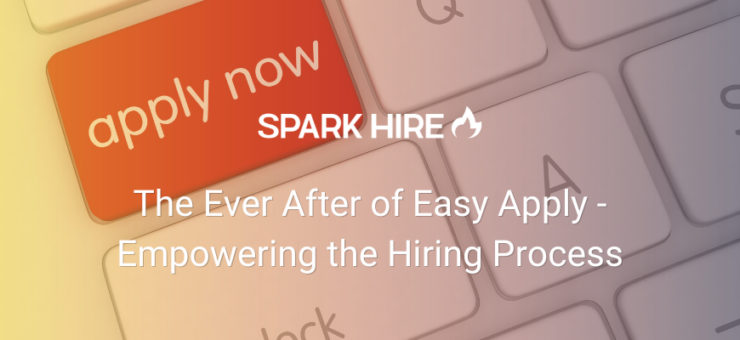One-Click
Among the new normals of our digital landscape, you’ve certainly seen the new crop of cheerful CTA buttons that invite you to Apply Now, One-Click Apply, and Easy Apply.
Perhaps you have been tempted to click. Why not? It’s so Easy to Apply.
But what do you suppose happens on the other side of that click?
Job seekers with unsettling tales of hundreds of applications sent and zero responses received joke that they end up directly in the trash, but TA teams tell a different story – one more complex than the direct-to-trash pipeline.
Anyone on the HR pro side knows that the issues faced by TA teams were elevated to a new level of “too much!” when the one-click trend took hold.
So no matter whose perspective we take, there’s trouble all around. Job seekers are uninspired, and TA teams are overwhelmed.
While we cannot control the tidal forces that led to our carefree and click-happy culture, we can (and should!) take action to improve the experience for recruiters and job seekers alike.
Delightfully simple solutions are within reach, and this article will highlight a particularly effective one. But first, we’ll take a deep breath in and take a big step back to get a holistic look at the current state of All The Things.
A Bad Pipeline and a Lukewarm Flood
Working at the convergence of a low barrier to entry and depleted employee engagement, recruiting teams report that one of the most distressing results of the Apply Now lifestyle is that they are drowning in underqualified applicants, and the employee experience has tanked.
Does this seem counterintuitive? If so, you may need to update your true-for-so-long-it’s-hard-to-let-it-go impression that the labor market is short of millions of entry-level workers. In fact, the opposite is true.
A recent Spark Hire study, Hiring Amid the Apply-Anyways Candidate Culture, uncovered evidence of an “Underqualified Applicant Overload Crisis.”
“In the years directly preceding the 2020 Global Pandemic, the main issue plaguing hiring professionals was an inability to fill entry-level positions because of talent being overqualified. Fast forward three years and we now struggle to fill empty seats due to a ‘skills gap’ and talent shortage of qualified applicants.”
I ran the numbers, and my math says the outcome is 100% bad. The only possible result of this convergence of factors is a mess.
Though AI boosts efficiency with its ability to rapidly parse and prune, many teams can’t keep up, and it’s of absolutely no use when it comes to improving the interview experience for the candidate.
Arguably, job seekers are in the worst position. According to the survey, a lack of process clarity coupled with infrequent or inconsistent communication contributes to candidate drop-out, which was the most cited challenge to the hiring process.
Nobody is fairing well, and this highly complex set of interwoven problems does not seem to lend itself to simple solutions…except that it does.
There is a Best Practice tool made just for this, and for most of us, it’s built into our hardware. It maintains a 100% customer retention rate that spans thousands of years and is available in every human language.
It’s the pinnacle of organic intelligence: human empathy.
For any eyes that just rolled, hear me out: I love tech. My professional focus lies at the intersection of people and our tools, and for decades I have proclaimed my belief that technological solutions can solve most human problems.
In fact, I make a living as a writer and editor focused on HR software.
But here’s the thing: to know the potential of technological solutions is to know their limits.
So let’s give the robots a rest and give a different tool a chance.
Less Tech, More Talk
After her interview on The Speed to Hire Show, where she testified to the importance of empowering everyone in the interview process, I spoke to Built In’s Stephani Studebaker about what’s working so well for them as they build their company.
At Built In, they apply an elegant solution that’s driven by the knowledge that, give or take, all problems are communication problems (my words, not hers).
That’s why their solution starts with empathetic engagement. By orienting their perspective to that of those involved, the core issue becomes clear: it’s distress. Nobody performs well under this kind of pressure, and whether the result is frustration, fear, confusion, or apathy, the effect is the same: time and money are wasted on ineffectual processes.
Rinse and repeat.
The Playbook
Built In uses an interview playbook. And that means so much more than what you’re thinking.
A good playbook is not a single-use map to be discarded at the end of the interview, it’s an invitation to take a guided tour of your company with a deep exploration of the Employee Value Proposition (EVP).
The playbook provides clarity on what to expect, and if something unexpected comes up (as it always does), it gives the candidate more than one point of contact for guidance.
Dispersing the workload across the hiring committee expands the candidate’s opportunity to learn and grants access to a more complete and representational picture of the company and the EVP.
This is a benefit for employees, as well. Empowered by the straightforward inventory of what is expected, they perform better as they evaluate the candidate. A good playbook can also ease the stress felt by some when, in addition to their daily duties, they must also contribute to hiring decisions.
Meeting every opportunity to make the candidate comfortable will result in the best, most representative performance of their skills. Given our click-happy ways and overflowing talent pools, leaving nothing to chance is more important than ever.
When it comes to interviews, our investment in the process should be proportional to the magnitude of negative consequences that follow hiring the wrong person or letting the right one go. Built In’s playbook is a low-effort, high-yield investment that will pay dividends deep into your company’s future.
 Featured Guest Expert – Alison Hunter
Featured Guest Expert – Alison Hunter
Writer, editor, HR Tech enthusiast Alison Hunter has worked at the intersection of people and tech for more than a decade. A multidisciplinary, lifelong learner, she brings an authoritative editorial voice, first-hand industry knowledge, and a people-first perspective to Select Software Reviews where she serves as HR Tech Editor.











